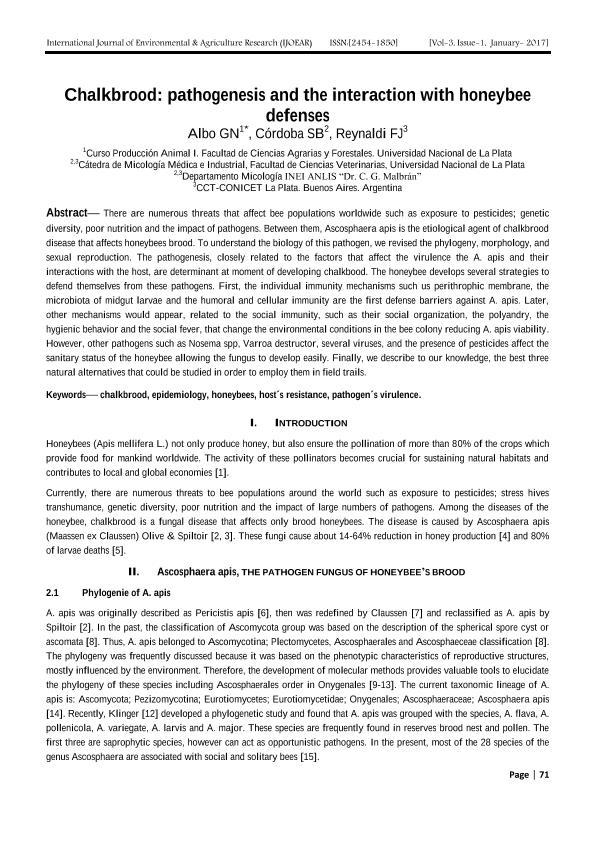Artículo
Chalkbrood: pathogenesis and the interaction with honeybee defenses
Fecha de publicación:
01/2017
Editorial:
Mukesh Arora
Revista:
International Journal of Environmental & Agriculture Research
ISSN:
2454-1850
Idioma:
Inglés
Tipo de recurso:
Artículo publicado
Clasificación temática:
Resumen
There are numerous threats that affect bee populations worldwide such as exposure to pesticides; genetic diversity, poor nutrition and the impact of pathogens. Between them, Ascosphaera apis is the etiological agent of chalkbrood disease that affects honeybees brood. To understand the biology of this pathogen, we revised the phylogeny, morphology, and sexual reproduction. The pathogenesis, closely related to the factors that affect the virulence the A. apis and their interactions with the host, are determinant at moment of developing chalkbood. The honeybee develops several strategies to defend themselves from these pathogens. First, the individual immunity mechanisms such us perithrophic membrane, the microbiota of midgut larvae and the humoral and cellular immunity are the first defense barriers against A. apis. Later, other mechanisms would appear, related to the social immunity, such as their social organization, the polyandry, the hygienic behavior and the social fever, that change the environmental conditions in the bee colony reducing A. apis viability. However, other pathogens such as Nosema spp, Varroa destructor, several viruses, and the presence of pesticides affect the sanitary status of the honeybee allowing the fungus to develop easily. Finally, we describe to our knowledge, the best three natural alternatives that could be studied in order to employ them in field trails.
Palabras clave:
Chalkbrood
,
Epidemiology
,
Honeybees
,
Host'S Resistance
,
Pathogen'S Virulence
Archivos asociados
Licencia
Identificadores
Colecciones
Articulos(CCT - LA PLATA)
Articulos de CTRO.CIENTIFICO TECNOL.CONICET - LA PLATA
Articulos de CTRO.CIENTIFICO TECNOL.CONICET - LA PLATA
Citación
Albo, Graciela Noemí; Córdoba, Susana Beatríz; Reynaldi, Francisco José; Chalkbrood: pathogenesis and the interaction with honeybee defenses; Mukesh Arora; International Journal of Environmental & Agriculture Research; 3; 1; 1-2017; 71-80
Compartir




